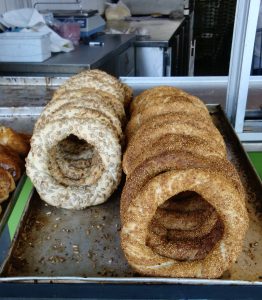If there’s one staple food that defines Turkey it is not the kebab but the humble loaf of bread (ekmek) that accompanies every single meal with the result that in 2000 the average Turk was estimated to eat their way through almost 200 kilos of bread in a year, putting them at the top of the league of big bread eaters. So sacred is bread in Turkish culture that it is regarded as sinful to throw it away – in rural areas in particular you may see people kiss stale bread and touch it to their forehead before placing it outdoors for passing animals and birds. Beggars will ask for ekmek parası (bread money) instead of asking for loose change.
The standard Turkish loaf is made of white bread and can be picked up at bakeries (fırıns), some of them owner by the state and offering “halk ekmeği (people’s bread)” for discounted prices. So ubiquitous is this basic loaf that one of my first experiences on moving to Turkey was of attempting to serve a Christmas dinner as a treat for Turkish friends, some of whom felt quite unable to relax into the experience without rushing out to buy bread to go with it!
White bread may be the staple but in big cities the bakeries often stock a range of other breads as well. Amongst the more specifically Turkish offerings are the pide breads, puffy flatbreads that are in particularly high demand during Ramazan when bakeries serve crispy Ramazan pidesi, fresh baked to coincide with the time of iftar – look out for queues waiting in front of especially favoured bakeries such as the Akmanoğlu Fırın in Eyüp which has been in business since 1883. Thicker than normal pide bread is spongy baslama which is sold in shops and makes an excellent pizza base or sandwich bread.
Outside of the towns and cities flatbreads remain a staple of family life, with yufka mass-baked in the autumn and stored to see it through winter. Most such breads are dehydrated and must be rehydrated before eating. A variant flatbread is lavaş ekmeği which arrives at the table inflated like a balloon and is delicious when hot and served with a dob of butter and a sprinkle of cheese. In traditional Turkish society women would gather in each other’s houses turn by turn to bake the winter’s bread supply.
Different regions of Turkey have different ways of cooking flatbreads. Sometimes it is cooked on concave griddles over a pit oven, at other times, especially in the south-east of the country, it is plastered against he inside walls of a raised oven.
Simits

Another quintessential Turkish bread product is the simit, a bread ring studded with sesame seeds that is a popular breakfast staple, especially for those on the go. There were always local variants on the simit which majored on size (Hatay) or flavouring. Traditionally simits were sold by men walking the street with trays on their head which sometimes came with simple stands that they could set up as and when. The authorities tidied that system up by introducing formal simit pushcarts where you can buy not just your simit but also a triangle of cheese and a bottle of water to go with it. But the snack was always too good to go unnoticed by big-money-makers and now many street corners have branches of Simit Sarayı (Simit Palace), offering ranges of fillings not dissimilar to bagels.
A popular İstanbul pastime is to grab a simit en route to a ferry, then share it with the seagulls off the upper decks.


